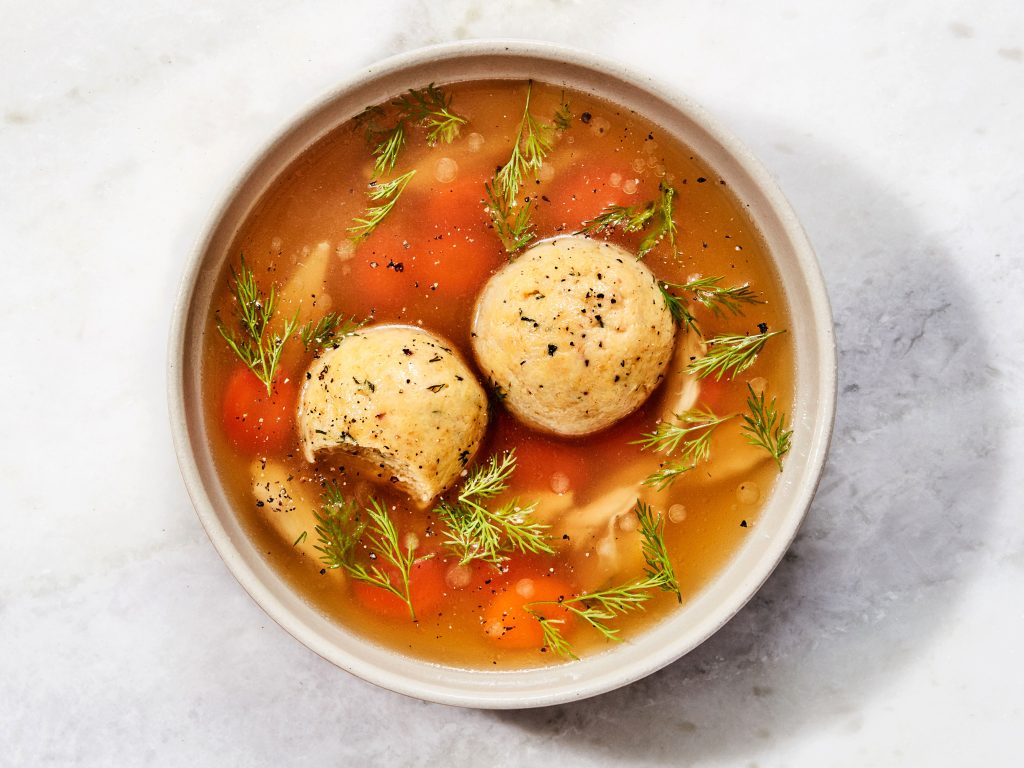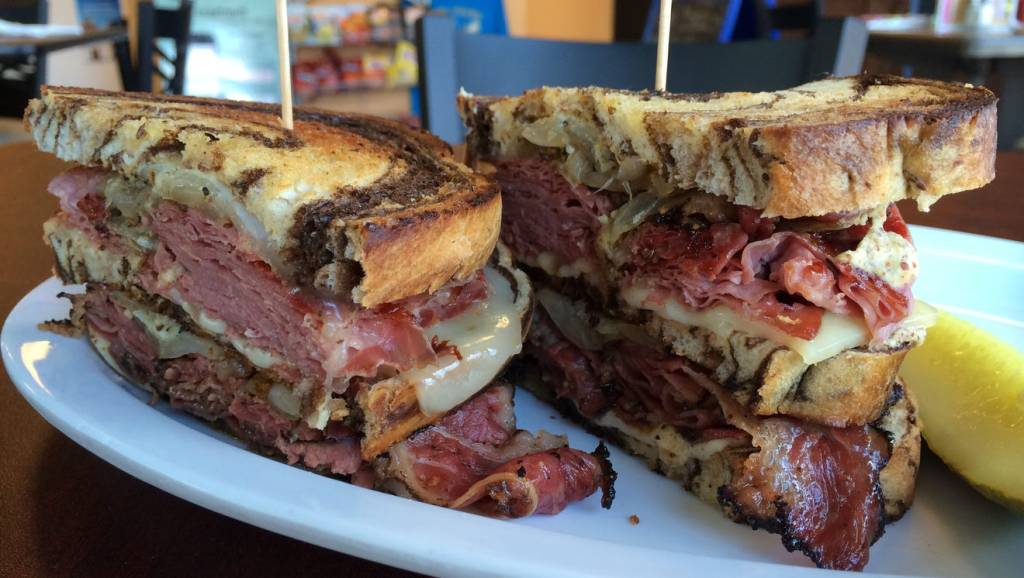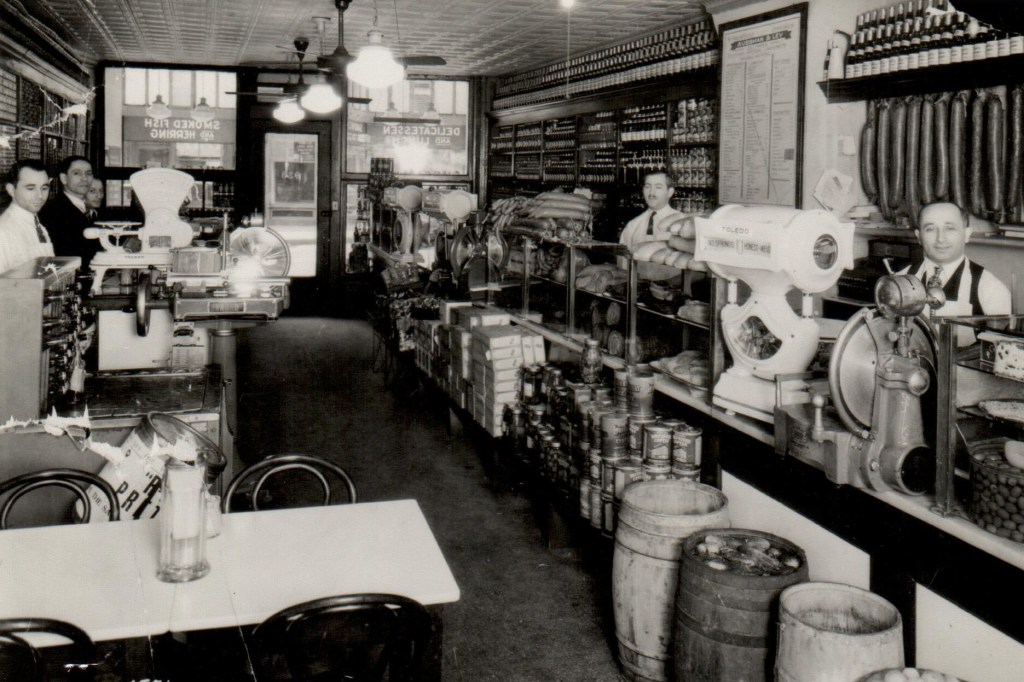Lindy’s Jewish delicatessen originally located at 1626 Broadway was a staple of New York City’s cuisine and culture in the 20th century. The picture of this renowned deli’s menu is from 1930 and it gives insight on how the enormous influx of those attempting to begin a new life in America, (primarily that of Ashkenazi Jews coming into Ellis Island) created the Jewish Deli explosion of the early 1900s. The “Deli” became a fixture of American cuisine in the 1920s/1930s and Lindy’s was one of the best of them. Incepted by Leo “Lindy” Lindermann and his wife Clara, Lindy’s was a prominent haunt that largely focused around traditional Jewish dishes consisting of various meats and fishes. Think of classics like brisket, corned beef, pastrami and chicken liver, these dishes cemented themselves as must haves at both deli’s such as Lindy’s and Passover seders alike. Meals that come from the sea like lox, tuna, and herring are items you are just as likely to see at a “break the fast” Yom-Kippur dinner as you are to gaze upon them at the table at this popular quintessentially American eatery. It is truly astonishing that the cuisine of such a small minority of the American population became so synonymous with the nation’s food culture. The specific fare that Lindy’s and Jewish immigrant owners such as Leo and Clara served up played an integral part in revolutionizing American taste.
The Masterminds Behind The Counter: Owners Clara and Leo “Lindy” Lindermann
Founder Leo Lindemann aka Leo “Lindy” was a Jewish immigrant from Berlin. In 1913, when Lindy was 25 he began working as a busboy at Palace Cafe (1568 Broadway) for Herman Gertner. Herman was also a German Jew and had immigrated to America right around the turn of the 20th century. By 1915 Herman had owned 5 restaurants on Broadway and soon thereafter promoted Leo to the position of manager of Palace Cafe where he met and eventually married Herman’s sister Clara. Leo and Clara opened Lindy’s first location at 1626 Broadway. The establishment stood as a broadway landmark from 1921 to 1957 when Leo died at 69 of Parkinson’s disease. Leo had another moniker “The Magnificent Ear” given to him for his willingness to listen to his favorite customers’ daily qualms. He even let many Broadway performers run up a tab when they were strapped for cash between performing on shows. He and his wife did not bear any children, but gave out toys and other gifts to kids who came into the restaurant with their parents during holiday seasons. It was said the Lindemann’s were incredibly modest people and no matter how popular their institution became they still worked just as hard as they had when they first opened.
Setting The Scene: 1930’s Broadway
Lindy’s attracted a very colorful crowd; a social register of Jews, gentiles, celebrities, columnists, writers and aspiring broadway actors/singers all hoping to be noticed by one another. Tablehopping became a dining room pastime and as with many delis at the time, Lindy’s became a communal gathering place of sorts for those looking to make connections and socialize. Right next store to Lindy’s stood the iconic Hollywood Theatre which opened its doors in 1930. The Broadway amphitheatre played host to some of the biggest shows of the 20th century. Plays such as “Calling All Stars,” “Romeo and Juliet” and “Ballet Russe de Monte Carlo” ran all throughout the 1930’s and 40’s, consequently bringing some of the biggest names in the industry to Lindy’s storefront.
Gaining National Notoriety: Guys and Dolls
In 1955, Lindy’s was given perhaps the greatest spotlight and free advertising a deli could ever receive when it was the focal point of a song in the hit musical “Guys and Dolls.” With a star studded cast including the likes of Marlon Brando, Vivian Blaine and Frank Sinatra, a large majority of the American public saw the film. In the musical Lindy’s is praised by multiple characters including a lyric where they state the cafeteria’s cheesecake to be so exceptional that it was perhaps the greatest in the world. The archetypal deli was also featured in an episode of “I Love Lucy” in which Ricky takes his entire band to celebrate after earning a big movie contract. On top of being featured multiple times on screens across the nation, Lindy’s was a frequently visited spot for famed actors and entertainers such as Groucho Marx, Dick Cavett and Woody Allen. It wasn’t’ all sunshine and rainbows however, as one of the news stories that garnered enormous hoopla for Lindy’s came on April 5, 1956. A mobster and hit man known as Abraham Telvi attacked a journalist named Victor Riesel with acid inside the restaurant which left Riesel permanently blind. But hey you know what they say, “there’s no such thing as bad publicity” am I right?
Best In The World? Their New York Cheesecake
As we previously touched on, Lindy’s was regarded by many to have the absolute best cheesecake around. The decadent cheesecake they dished out were favorited by both the highest status individuals in NYC, and some of the most cold-blooded mobsters the city’s criminal underbelly possessed. Quite controversially Arnold Reuben, a Jewish-German immigrant, claimed to have been the original inventor of the New York cheesecake. Legend has it that Lindy apparently bribed Reuben’s baker for the recipe resulting in the dessert of mythical proportions. There is contention as to what the official story actually is, moreover what the official recipe of the epochal cheesecake even was. Nevertheless, chefs and dessert fanatics alike have come to a general consensus as to what the cake calls for. The recipe is widely considered to be as followed: 1 cup flour, 1/4 cup sugar, 1 teaspoon grated lemon peel, 1/2 teaspoon vanilla extract, 1 egg yolk, 1/4 cup butter, 5 packages (8 ounce size) cream cheese, 1 3/4 cup sugar, 3 tablespoons flour, 1 1/2 teaspoon grated lemon peel, 1 1/2 teaspoon grated orange peel, 1/4 teaspoon vanilla extract, 5 eggs, 2 egg yolks and 1/4 cup heavy cream.
Authentically Jewish Grub: Corned Beef, Gefilte Fish, and Matzah Ball Soup
Lindy’s was not only a cheesecake joint, it also served up some of the most quintessential and delicious Jewish Delicatessen provisions. Starting off with Lindy’s famed corned beef sandwich known for its generous helping of beef and mouth-watering flavor. Corned beef at Lindy’s was brisket that was brined for multiple weeks (perhaps up to a month), steamed until perfectly tender, and then sliced up to be pilled up high between two pieces of bread. Next up was Lindy’s Gefilte Fish which translates from Yiddish as “stuffed fish.” This stemming from the fact that the dish is made by grinding up deboned fish (usually whitefish) and adding filler ingredients like breadcrumbs, eggs, and vegetable scraps. The fish is also usually served with horseradish and a leavened bread known as Hallah (or unleavened bread called Matzah if it is Pesach). Gefilte fish was guaranteed to be present at Lindy’s during the 1930’s at any given time of day, similarly to how it can’t be missed as an appetizer at a Rosh haShanah dinner (the Jewish New Year). Last but certainly not least, the final genuinely Jewish menu item that will be highlighted from Lindy’s is the beloved Matzah ball soup. Similar to that of Gefilte fish, Matzah ball soup can be found at any Jewish high holiday meal and is a dish originating from Ashkenazi Jewish cuisine. It is a chicken soup filled with dumplings made out of matzah meal (which is crushed unleavened bread), eggs, chicken fat, carrots, parsley and a soup broth.
Cultural Diffusion: Tweaking And Accounting For American Taste and Experience
Though it did do the traditional Jewish eats incredibly well; Lindy’s like many ethnic estaurants during the early 20th century, took influences from American cuisine and dining culture in order to create a unique and enjoyable experience for its patrons. Perhaps no better example of a dish that symbolized this synthesis of American and Ashkenazi Jewish fare than the “Lindy’s special.” The special was a huge and one of a kind sandwich consisting of turkey breast, smoked tongue, Bermuda onions, Swiss cheese, coleslaw and Russian dressing. This dagwood sandwich became Lindy’s most popular, as it took flavors and nodes of both its original Askenazi roots and its new home of American taste. On top of having certain meals that were guided by American society, Lindy’s was also famous for having what became dubbed “Jewish” waiters. These servers were notorious for their wisecracks and quick one-liners. The waiters at Lindy’s would often get fed up with customers who did not know what they wanted. According to many, part of a deli waiter’s function at Lindy’s was to piss off the hungry, scare the cautious and rule the diets of the customers with an iron fist. Now these waiters weren’t always necessarily Jewish; in fact many of these so-called “Jewish” waiters were your run of the mill Greek, German, Italian, Hungarian, or even Swiss immigrants. What made these workers “Jewish” waiters was by the way in which they acted and carried themselves. This is very fitting as that sentiment is incredibly similar to prevailing American ideology: what makes one “American” isn’t where they come from, but what they believe in and accomplish once they get to this great country.
Citations:
Fickenscher, Lisa. “Historic NYC Eatery Lindy’s Prepares to Close up Shop.” New York Post, New York Post, 15 Dec. 2017, https://nypost.com/2017/12/14/historic-nyc-eatery-lindys-prepares-to-close-up-shop/.
Lindermann, Leo Lindy. “Lindy’s, New York 1930s.” Vintage Menu Art, 2021, https://vintagemenuart.com/products/lindy-s-new-york-1930s.
Gornick, David. “Leo Lindemann of Lindy’s Was 69; Host to Show Folk at His Popular Restaurant, Scene of Runyon Tales, Dead Native of Berlin Saved for Eight Years.” The New York Times, The New York Times, 25 Sept. 1957, https://www.nytimes.com/1957/09/25/archives/leo-lindemann-of-lindys-was-69-host-to-show-folk-at-his-popular.html.
Manhattan. “50th Street & Broadway in Front of Lindy’s Restaurant .” Oldnycphotos.com, Jan. 1930, https://oldnycphotos.com/products/50th-street-broadway-in-front-of-lindys-restaurant-1957-midtown-manhattan-new-york-ny. Accessed 1 Dec. 2021.
Pelz, Rachel. “New York’s Most Famous Dessert Is Harder to Find than You’d Think.” Thrillist, 2017, https://www.thrillist.com/eat/new-york/best-new-york-cheesecake-in-nyc.
INC, Playbill. “Hollywood Theatre.” Playbill, 1930, https://www.playbill.com/venue/hollywood-theatre-vault-0000000197.
Corman, Avery. “New York Cheesecake: From Guys and Dolls Onward.” HuffPost, HuffPost, 7 Dec. 2017, https://www.huffpost.com/entry/new-york-cheesecake-from_b_604504.
Sweeting, Adam. “Guys and Dolls.” The Arts Desk, 20 Dec. 2014, https://theartsdesk.com/film/guys-and-dolls.
Ritchie, Karen. “Lindy’s New York Deli Cheesecake Recipe.” Moms Who Think, 14 Sept. 2019, https://www.momswhothink.com/lindys-new-york-deli-cheesecake/.
Bence, Bill. “Lindy’s: Already Legendary in 1946.” A Week in New York April 1946, 3 Sept. 2010, http://nyapril1946.blogspot.com/2010/09/lindys-already-legendary-in-1946.html.
Fleischmann, Rachel. “Lindy’s Original New York Cheesecake.” Kosher, 2017, https://koshereye.com/desserts/1751-lindys-original-new-york-cheesecake.html.
Boeuf, Jean Le. “JLB Picks: 5 Places for Crazy-Good Corned Beef.” Press, The News-Press, 16 Mar. 2017, https://www.news-press.com/story/life/food/jean-le-boeuf/2017/03/15/best-corned-beef-fort-myers-naples-cape-coral-irish-restaurants-st-patricks-day-where-to-eat/99147450/.
Lowin , Rebekah. “Gefilte Fish Haters, Here’s Why You Should Reconsider Your Stance.” Food & Wine, 24 May 2017, https://www.foodandwine.com/news/gefilte-fish-haters-heres-why-you-should-reconsider-your-stance.
Channel, Cooking. “Gefilte Fish.” Cooking Channel, Cooking Channel, 8 June 2015, https://www.cookingchanneltv.com/recipes/gefilte-fish-2125139.
Budget, Beth. “Matzo Ball Soup.” Budget Bytes, 18 Mar. 2021, https://www.budgetbytes.com/matzo-ball-soup/.
Baz, Molly. “BA’s Best Matzo Ball Soup.” Bon Appétit, Bon Appétit, 8 Apr. 2019, https://www.bonappetit.com/recipe/bas-best-matzo-ball-soup.
Stevens, Brett. “Thinly Sliced Ham and Veggies atop a Wooden Cutting Board Stock Photo.” Getty Images, 2018, https://www.gettyimages.in/photos/smoked-turkey-sandwich. Gorelick, Richard, et al. “The Deli as a Symbol of the American Jewish Experience.” JMORE, 9 Nov. 2017, https://jmoreliving.com/2017/10/31/deli-symbol-american-jewish-experience/.








